The price of a boat is influenced by a myriad of factors, each contributing to the overall valuation of the vessel. One of the most significant determinants is the type of boat itself. For instance, luxury yachts, fishing boats, and sailboats each occupy different segments of the market, with varying price points.
A high-performance yacht equipped with state-of-the-art technology and luxurious amenities can command prices in the millions, while a simple fishing boat may only cost a few thousand dollars. The materials used in construction also play a crucial role; boats made from fiberglass or aluminum tend to be more affordable than those crafted from exotic woods or high-grade composites. Another critical factor is the age and condition of the boat.
Newer models typically come with warranties and the latest technology, which can justify a higher price tag. Conversely, older boats may require significant maintenance or upgrades, which can deter potential buyers or lower the asking price. Additionally, market demand can fluctuate based on seasonal trends, economic conditions, and consumer preferences.
For example, during peak boating season, prices may rise due to increased demand, while off-season sales may offer more competitive pricing as sellers look to offload inventory.
Key Takeaways
- Boat prices are influenced by factors like size, brand, age, and condition.
- Various boat types have distinct price ranges, from affordable small boats to expensive luxury yachts.
- New boats offer warranties and latest features, while used boats are cheaper but may need more maintenance.
- Additional costs include insurance, maintenance, storage, and registration fees.
- Effective negotiation and exploring financing options can help secure the best deal on a boat purchase.
Different Types of Boats and Their Price Ranges
The boating industry encompasses a wide variety of vessels, each designed for specific purposes and activities. Powerboats, for instance, are popular for recreational use and can range from small runabouts priced around $10,000 to larger cabin cruisers that can exceed $100,000. Sailboats also vary significantly in price; entry-level models suitable for beginners may start at $15,000, while high-performance racing yachts can reach several million dollars.
In addition to powerboats and sailboats, there are specialized vessels such as fishing boats, pontoon boats, and personal watercraft (PWCs). Fishing boats can range from $20,000 for basic models to over $200,000 for fully equipped offshore fishing machines. Pontoon boats, known for their stability and spaciousness, typically fall within the $15,000 to $50,000 range depending on size and features.
PWCs are often more affordable, with prices starting around $5,000 for entry-level models and going up to $20,000 for high-performance versions. Understanding these categories and their respective price ranges is essential for prospective buyers to make informed decisions.
When considering a boat purchase, one of the primary decisions is whether to buy new or used. New boats offer several advantages, including the latest technology, warranties, and customization options. Buyers can select specific features tailored to their preferences, ensuring that the vessel meets their exact needs.
Additionally, new boats often come with manufacturer support and service plans that can provide peace of mind regarding maintenance and repairs. However, purchasing a new boat also comes with drawbacks. The initial depreciation can be steep; a new boat can lose a significant portion of its value within the first few years.
This rapid depreciation can be a concern for buyers who may want to resell in the near future. On the other hand, used boats present an opportunity to acquire a vessel at a lower price point. Buyers can often find well-maintained used boats that have already undergone initial depreciation, allowing them to get more value for their money.
Nevertheless, buying used comes with its own set of challenges. The condition of a used boat can vary widely based on its age and how well it has been maintained. Potential buyers must conduct thorough inspections and possibly invest in surveys to assess the vessel’s condition accurately.
Additionally, older boats may lack modern features or require upgrades to meet current safety standards or performance expectations.
Additional Costs to Consider When Buying a Boat

Beyond the purchase price of the boat itself, prospective buyers must consider various additional costs that can significantly impact their overall investment. One of the most substantial ongoing expenses is maintenance. Regular upkeep is essential to ensure the boat remains in good working condition and retains its value over time.
This includes routine tasks such as cleaning, engine servicing, and hull inspections. Depending on the size and type of boat, annual maintenance costs can range from a few hundred to several thousand dollars. Insurance is another critical expense that should not be overlooked.
Boat insurance protects against potential damages or liabilities that may arise while operating the vessel. The cost of insurance varies based on factors such as the boat’s value, type, usage frequency, and the owner’s experience level. Additionally, storage fees can add up quickly; whether opting for marina slips or dry storage facilities, these costs should be factored into the overall budget.
Fuel costs are also an important consideration for boat owners. Depending on how often and how far one plans to travel on the water, fuel expenses can become significant over time. Furthermore, if the boat is equipped with advanced electronics or other high-tech features, there may be additional costs associated with upgrading or maintaining these systems.
How to Negotiate the Best Price for a Boat
| Negotiation Step | Key Metric | Recommended Value/Range | Notes |
|---|---|---|---|
| Research Market Value | Price Range for Similar Boats | Within 5-10% of average market price | Use online listings and dealer prices for comparison |
| Initial Offer | Percentage Below Asking Price | 10-20% | Start lower to leave room for negotiation |
| Inspection & Condition Assessment | Repair Cost Estimate | Up to 15% of asking price | Use as leverage to negotiate price down |
| Negotiation Duration | Number of Negotiation Rounds | 3-5 rounds | Be patient but avoid dragging negotiations too long |
| Final Price | Discount Achieved | 5-15% below asking price | Depends on boat condition and seller motivation |
| Payment Terms | Deposit Percentage | 10-20% | Secure the deal with a reasonable deposit |
| Additional Costs | Estimated Taxes and Fees | 5-10% of final price | Include registration, taxes, and insurance |
Negotiating the price of a boat requires preparation and strategy to ensure that buyers secure the best possible deal. One effective approach is to conduct thorough research on comparable vessels in the market. By understanding the average prices for similar boats in terms of age, condition, and features, buyers can establish a reasonable price range for negotiations.
This knowledge empowers them to make informed offers rather than relying solely on the seller’s asking price. Another key aspect of negotiation is being willing to walk away if the terms do not meet expectations. Sellers are often more inclined to negotiate when they sense that a buyer is not desperate to make a purchase.
Building rapport with the seller can also facilitate smoother negotiations; expressing genuine interest in the boat while remaining firm on budget constraints can create a positive atmosphere for discussion. Additionally, timing plays a crucial role in negotiations. Purchasing during off-peak seasons or when sellers are eager to close deals can lead to more favorable pricing outcomes.
Buyers should also be prepared to discuss any necessary repairs or upgrades that may impact the boat’s value during negotiations; highlighting these factors can provide leverage in securing a lower price.
Financing Options for Purchasing a Boat
Financing a boat purchase is an important consideration for many buyers who may not have sufficient cash reserves available upfront. Various financing options exist to accommodate different financial situations and preferences. Traditional bank loans are one common route; these loans typically offer competitive interest rates and flexible repayment terms based on creditworthiness.
However, securing financing through banks may require extensive documentation and proof of income. Another option is marine financing companies that specialize in loans specifically for boats and other recreational vehicles. These lenders often have more lenient requirements compared to traditional banks and may offer tailored loan products designed for boat buyers.
Interest rates may vary based on factors such as credit score and loan term length. Leasing is another alternative that some buyers consider; this option allows individuals to use a boat without committing to full ownership upfront. Leasing agreements typically involve lower monthly payments compared to traditional loans but may come with restrictions regarding usage and modifications to the vessel.
Tips for Finding the Best Deals on Boats

Finding the best deals on boats requires diligence and strategic planning. One effective method is to explore multiple marketplaces beyond traditional dealerships; online platforms such as Craigslist, Facebook Marketplace, and specialized boating websites often feature listings from private sellers who may be more willing to negotiate on price compared to dealerships. Networking within local boating communities can also yield valuable insights into upcoming sales or private listings that may not be widely advertised.
Attending boat shows or local marine events provides opportunities to connect with sellers directly while gaining firsthand knowledge about various models and their features. Timing is another critical factor when searching for deals; purchasing during off-peak seasons or at the end of model years when dealers are looking to clear inventory can lead to significant savings. Additionally, being open-minded about different brands or models can expand options and increase chances of finding a great deal.
Understanding the Resale Value of Boats
The resale value of a boat is an essential consideration for buyers who may eventually want to sell their vessel down the line. Several factors influence how well a boat retains its value over time. One primary determinant is brand reputation; well-known manufacturers with a history of quality craftsmanship tend to have better resale values compared to lesser-known brands.
The type of boat also plays a significant role in determining resale value; certain categories like fishing boats or luxury yachts may hold their value better than others due to consistent demand in those markets. Additionally, maintaining meticulous records of maintenance and upgrades can enhance resale prospects; potential buyers are often willing to pay more for vessels that have been well cared for. Market trends should also be monitored as they can impact resale values significantly; shifts in consumer preferences or economic conditions can lead to fluctuations in demand for specific types of boats.
Understanding these dynamics allows sellers to time their sales strategically for optimal returns on their investments. In conclusion, navigating the complexities of boat pricing involves understanding various factors that influence costs, exploring different types of vessels within specific price ranges, weighing the pros and cons of new versus used options, considering additional expenses beyond purchase prices, negotiating effectively with sellers, exploring financing avenues, seeking out deals through various channels, and comprehending how resale values fluctuate over time based on market conditions and brand reputation.


